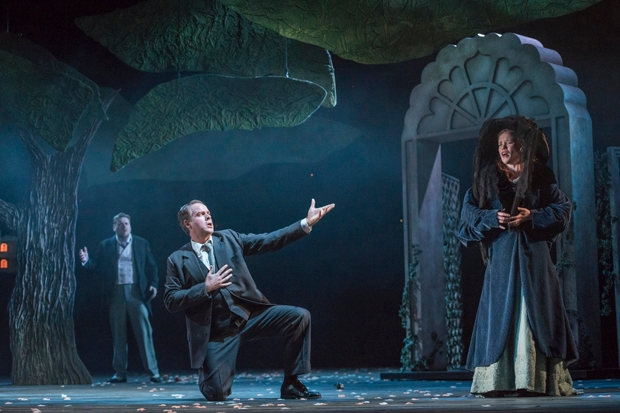Comedy and tragedy sit close beside one another in Mozart’s operas. Whether it’s the grinning horror of the Così finale — lovers joined, perhaps for ever, to the wrong partners — or the violence and mental instability so barely contained in the flimsy comic fabric of La finta giardiniera, there’s a continuum of emotion that belies the easy binaries of opera buffa and opera seria. Two new productions explore the shifting light of the composer’s chiaroscuro world, letting sunshine into the near-tragedy of Idomeneo and glancing into the darker corners of Le nozze di Figaro.
Washed up on to Garsington Opera’s stage in two enormous shipping containers, Tim Albery’s Idomeneo is a soberly beautiful meditation on exile, loss and sacrifice — Shakespearean-rich despite deep cuts to the score. Gone is the garish sea monster that ravages Crete in Mozart’s original, replaced by a more abstract (but no less terrifying) foe, and even the Old Testament extremity of the climactic scene — Idomeneo’s would-be sacrifice of his son Idamante — is played with a delicacy that horrifies as no blood and thunder could.
But among some very real tragedy — the echoes of the refugee crisis lightly sounded in Hannah Clark’s deft designs, Toby Spence’s Idomeneo wracked with all the self-doubt and conflicting urges of a Peter Grimes — there’s real joy to be found. Caitlin Hulcup’s Idamante, all adolescent awkwardness and intensity, overflows with ardour for his beloved Ilia, reciprocated with shy delight by Louise Alder. Dramatically it’s a near-perfect pairing, finding the youth and even the silliness in two lovers whose sophistication is only a veneer painted on by suffering. Vocally, too, from Hulcup’s impassioned ‘Non ho colpa’ to Alder’s ‘Zeffiretti lusinghieri’, defiant in its radiant beauty, these are exceptional performances that rise to the challenge of conductor Tobias Ringborg’s speeds and forward-thrusting musical momentum.
It’s hard to believe that Spence makes his role debut here. This Idomeneo is a rich psychological portrait, all the more interesting for its unusual vocal colouring. Still a lighter, higher-lying tenor than we might associate with the role (though growing in weight and interest each season), Spence works this rangy quality to his advantage. His huge set-piece ‘Fuor del mar’ has an edginess that’s strategically deployed: musical loveliness sacrificed for dramatic truth. Sharing Spence’s risks, if not quite his control, Rebecca von Lipinski’s Elettra is a woman so close to the edge as to lose her vocal footing a couple of times, but Albery makes sense even of this. Drawing our eye continually to her, he dares his audience to ignore the figure whose desires and dreams are so totally shattered by the ‘happy’ ending, a loose narrative thread unravelling even as we watch.
But if Albery’s play of light and shade brings Mozart’s often awkward Idomeneo into focus, the same cannot always be said of Thomas Guthrie’s Figaro. It was only a matter of time before we got a Downton Figaro, and it’s a canny choice of setting, elegantly rendered in Rhiannon Newman Brown’s designs. Swapping one historical flashpoint for another, Guthrie reimagines the class conflict of pre-Revolutionary Europe among lords of the manor and their loyal retainers. Cherubino’s khaki and tin hat are a poignant suggestion of the fate of this irrepressible boy and his contemporaries — a loss of innocence so much crueller and more violent than the sexual awakening of ‘Voi che sapete’.
What a shame, then, that the production that inhabits this promising space is so blankly non-committal. All humour (save that of the text itself) is excised in pursuit of a naturalism so subtle that it leaves us stranded somewhere between comedy and tragedy. With no dramatic signposts to orient us (and no visual jokes to divert us, not in Susanna and Marcellina’s acid duet, nor the farcical goings-on with Cherubino and the Count, nor even the business of the letter) we’re left to write our own adventure — nowhere more so than in the finale, where the uncomplicated reconciliation between Count and Countess seems less a deliberate ambiguity and more an abnegation of directorial responsibility.
A talented young cast do their best with what they’re given. Susanna Fairbairn’s Countess does with her voice what she is not allowed to do in movement, projecting a desperate despair calcified into an uneasy restraint. The charged pianissimo of her ‘Dove sono’ carries all the anguish of a musical scream, unheeded by Benjamin Bevan’s under-characterised but warmly sung Count. Subdued and serious, Grant Doyle’s Figaro is a long way from the larky creature we’re used to, but a fine foil for Beate Mordal’s gentle Susanna.
There’s little excitement from Robert Houssart’s stolid pit, except in ensembles, where orchestra and stage consistently part company. Musically, as dramatically, this Figaro has traded high-energy humour for something heavier, darker. But if it glances into the darkness, this production never quite plucks up the courage to step into it, leaving Figaro and his bride standing, quite literally, in no-man’s-land.






Comments